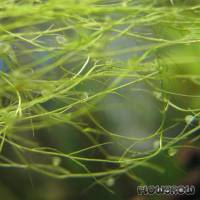



Utricularia gibba, dwarf bladderwort, is a widely distributed carnivorous plant that feeds on small animals. It is found in many warmer regions of the earth in bogs and on the edges of ponds. It truly is an interesting plant, however, it is only of limited use in a planted tank. It is most often introduced involuntarily. This bladderwort forms floating cushions under the water surface, but it can also settle between other plants or grown emersed on wet ground.
U. gibba does not have any finely pinnate leaves growing in whorls like most other aquatic bladderwort species but tiny, almost stunted-looking leaflets that grow sparsely on the threadlike, thin stems. These leaves carry the bladder traps that serve the plant for catching its prey, which consists of tiny aquatic organisms; fish fry or shrimplets are completely safe from these tiny bladder traps, and the tangled U. gibba plants provide them with some great cover.
However, this bladderwort may soon become a nuisance, and many an aquascaper has already cursed it, as it is often interwoven with other plants due to its tangled growth habit. It tends to establish itself especially in moss pads or in lawnlike plantings.
Other than with algae or cyano bacteria, appropriate fertilisation and the maintenance of an aquarium environment that is beneficial to higher plants do not help to keep it in check, as it will grow under a lot of different conditions and as its demands are identical with those of most other aquarium plants. The only method to keep U. gibba in control is its patient and persistent removal with the help of a pair of pincers. When doing so, please keep in mind that this bladderwort can regenerate from even the tiniest stem pieces that remain in the aquarium. It is thus most recommendable to not introduce it at all and to search anything that is to be put into the aquarium for shoots or stem pieces of U. gibb.
Of course, U. gibba is highly interesting for those who like carnivorous plants, though. Its light yellow flowers that grow above the waterline are relatively large compared with the rest of the plant, and can look rather nice. Flower formation is furthered if the plant grows in very shallow water or just on wet soil.
<a href="https://www.flowgrow.de/db/aquaticplants/utricularia-gibba" target="_blank"><img alt="Utricularia gibba" title="Utricularia gibba" src="https://www.flowgrow.de/db/widget/aquaticplants/utricularia-gibba" /></a>
[url=https://www.flowgrow.de/db/aquaticplants/utricularia-gibba][img]https://www.flowgrow.de/db/widget/aquaticplants/utricularia-gibba[/img][/url]
[widget=aquaticplants/utricularia-gibba]Utricularia gibba[/widget]